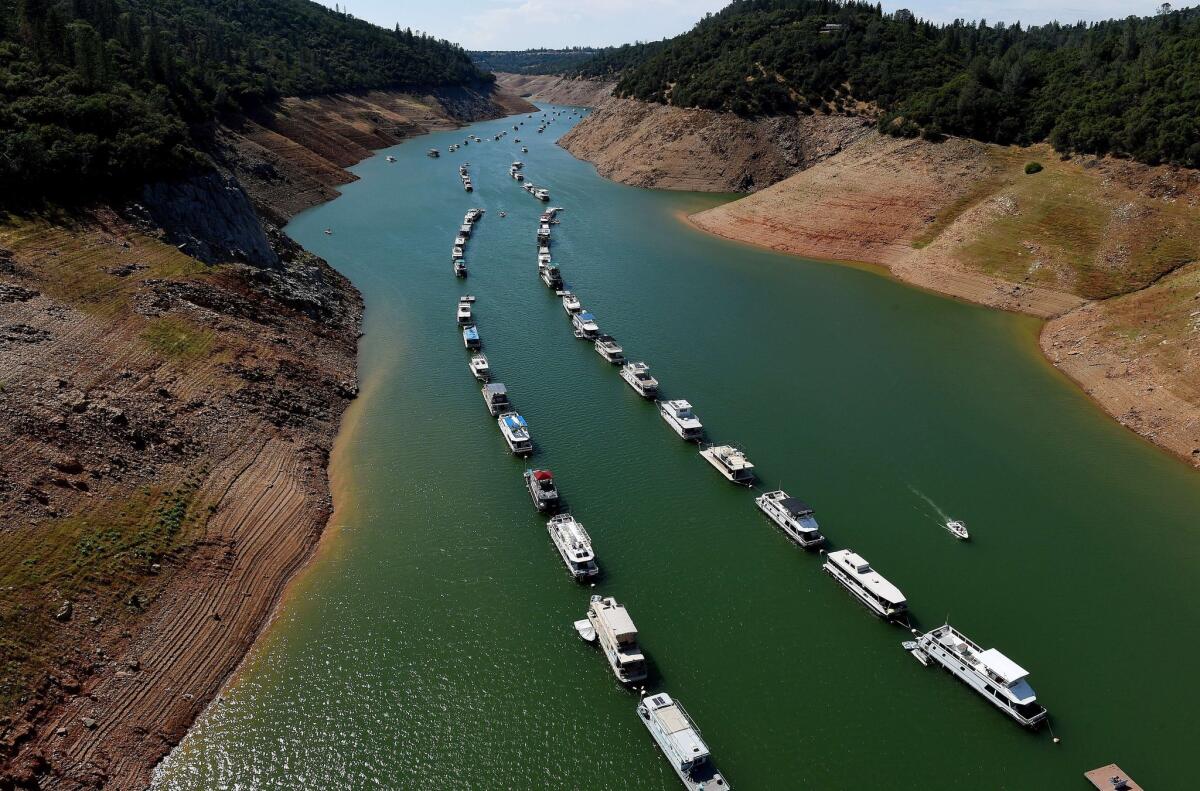California water losses ‘huge,’ new thinking required on drought, panel says

Houseboats are moored on a shrinking arm of the Oroville Lake reservoir, which is now at 25% capacity because of the drought.
A panel of water experts mapped out the challenges California faces in meeting future demands for water at a time when water sources are under stress and supplies appear uncertain.
The panel, speaking at the Los Angeles Times book club, agreed the problems are serious and multifaceted: groundwater reserves underneath California’s Central Valley are estimated to have been depleted by 125 million acre-feet since the first wells were drilled more than a century ago and as water demand is forecast to outstrip supply coming from the Colorado River in the coming decades.
“What we’re really looking at is about a 20% problem of our supply being lost to climate change and over demand, and that’s huge,” said Jeff Kightlinger, general manager of the Metropolitan Water District of Southern California, at a discussion of the book “Cadillac Desert,” by Marc Reisner.
Among some of the challenges California is set to face, experts said at a panel discussion Sunday moderated by Los Angeles Times Publisher Austin Beutner at the city’s Hyperion Treatment Plant:
Unsustainable use of groundwater
Water levels are getting lower underground, some wells are going dry, there’s a need to drill even deeper wells, and California until last year had no regulations on groundwater pumping, said David Hayes, former deputy secretary at the Interior Department under Presidents Clinton and Obama. “We’re clearly pumping unsustainably, and it will be a while before that law fully kicks in,” Hayes said.
Pumping river water through a sick delta
Southern California gets a huge portion of water by turning on giant pumps that cause one of the state’s largest rivers, the San Joaquin, to flow artificially backward in an environmentally sensitive delta. “That creates all sorts of challenges to the endangered species, with fish, migrations,” Kightlinger said.
There’s a potential solution: Building tunnels that would allow water to be pumped from the water-rich Sacramento River around the delta, instead of through it, said Mike Sweeney, executive director of the Nature Conservancy in California.
But how big do you make it? Big enough to get water down south during years of floods? Would that give Southern California an excuse just to take all the
water it can even during dry years?
“Northern Californians don’t trust you guys,” Hayes said to laughter. “And with some good reason.”
Less flexibility on farms during droughts
Up until 15 years ago, it was easier for the Metropolitan Water District to pay farmers to leave their fields fallow during droughts so cities could use the water.
Not anymore. California’s farmers have increasingly focused on lucrative almonds, walnuts and pistachios as other crops got cheaper after the passage of the North American Free Trade Agreement. But almond trees need to be watered all the time and don’t offer the flexibility of row crops where fields can be left fallow during dry years.
“That has greatly tightened our demand on water,” Kightlinger said. “It’s one of the reasons why this drought is so difficult to deal with, because there is very little flexibility now within our water system.”
Climate change has given the state a less reliable supply of water
A key source of stability to California’s water supply in the last century was the snowpack.
It stores precipitation as ice in the mountains, melting slowly through the summer, giving the cities water at a comfortable pace instead of at flash-flood speeds in the winter.
“That snowpack is going away,” Hayes said. It will be difficult to figure out how to store that precipitation if it comes down as rain instead of snow.
The economics of what’s the most beneficial use of California’s water
Does it make sense to send cheap crops abroad if the water used to grow them could be put to better use in California? Should there be a discussion of what types of crops should be planted? Perhaps, “but that’s a big, big policy change. Right now, in California and in the United States, we don’t tell folks what they can or cannot plant,” Hayes said.
Still, there is a possible precedent. In California, it took years for a law to be passed requiring residential developers to prove that they would have a water supply. “It’s not much of a leap from there to call on farmers to show if they’re going to change crop patterns and use more water that they’ve got a water source. I’m not suggesting that, I’m just pointing that out,” Hayes said.
There could be other ways to get farmers to think more about being more water efficient, Hayes said, such as state officials sharing information with them on what the most water-efficient farms are doing.
Read more Times coverage of the drought here.
Sign up for The Times’ new drought newsletter, Water and Power, here.
Twitter: @ronlin
More to Read
Sign up for Essential California
The most important California stories and recommendations in your inbox every morning.
You may occasionally receive promotional content from the Los Angeles Times.











